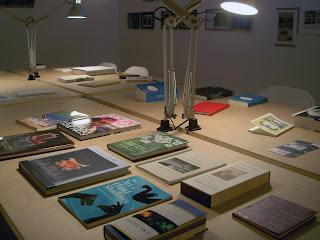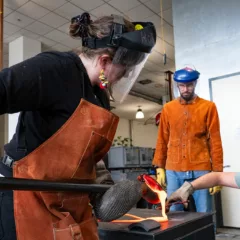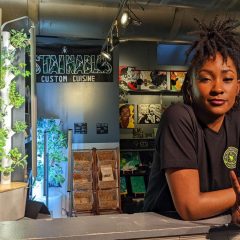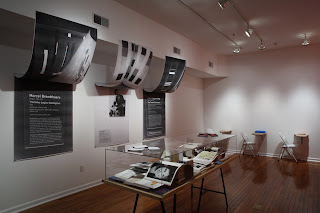
Installation view of Volume Attempts; the space of books at Tyler Gallery
The premise of the extraordinary exhibition, Volume Attempts: The Space of Books at Tyler School of Art’s Temple Gallery in Old City (through October 25, 2008) is that books are more than passive containers for ideas. Rather they are malleable objects with which we have intimate relationships, usually conducted in private and involving our touch as well as our gaze. It’s the only book exhibition I’ve ever seen that acknowledges that books must be held and perused page-by-page in order to be appreciated. If you love books, don’t miss this exhibition!
The curators, Purtill Family Business, designers of books for artists, galleries and museums, have created a landscape of books: literally so in the first gallery, where the only books that can’t be handled are arranged in a flat case (above). Selected from a table at the firm’s studio, the books nestle open, one upon another, fold-outs drape themselves over stacks of books and one small pamphlet hangs outside of the case, held in place by magnets. It’s possible that they lie that way in the studio, but I suspect it is closer to the designers’ fantasies than to actual practice.
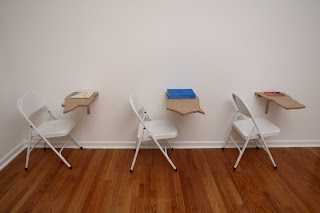
Individual reading stations in the gallery; felt a bit like being at a school desk.
On the wall beside the case hang three large, paper banners with images of labels from Book/Shelf, an exhibition at MoMA earlier this year; they refer to books by On Kawara, Marcel Broodthaers and Allan Kaprow, and their spirits oversee the exhibition. The bulk of the books on display are laid out on four large tables in the back room and at three small, cantilevered reading stations in the front. The wall running between the rooms has a band of images of double-page spreads; they were commissioned from graphic designers by artists Christoph Keller and Jerome Saint-Loubert Bie. Double Spread includes some bindings, some purely textual spreads, others purely visual and some, I suspect, that only exist in the designers’ heads (and computer files).
The selection of books was made by a number of different people including dealer Matthew Marks, art publisher Christoph Keller, writer William Pym and curator and editor Bettina Funcke; the books are grouped according to their selector. In the art world there are books illustrated by artists, books of artists’ writing, books written about artists and artists’ books, which are considered to be art (a particularly messy category and mostly distinct from the others by the artists’ intent; I was going to suggest that what distinguishes them is the lack of ISBN designations, but I’m not really sure that holds). The Space of Books includes all of them and more.
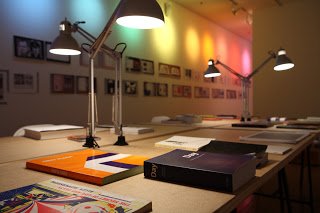
Matthew Marks included the National Audubon Society Field Guide to the Night Sky as well as a small monograph, Man Ray Stamps. Bettina Funcke chose the legendary picture book for adults: Robert Frank’s Zero Mostel Reads a Book, which underlines what might be the exhibition’s theme that books create an arena for the imagination. William Pym included one extraordinary volume, extraordinary, that is, because of its form: FOS’s Liquid Chain in the Vapor Wall has pages cut to different depths throughout the volume, so it resembles one book nestling within another. Cristoph Keller’s selections were books he’d published, including Hellen Mira’s Cloud, the, 3 which appeared to be a series of single-line poems, each with a page to itself and the text differently-positioned on each page. The text turned out to be an imaginary index to a volume of lectures by John Dewey, the poetry being Mira’s choices and placement within the space of each page; another investigation of the space of books.
The exhibition has various other components, including small artists’ books commissioned from Zoe Strauss and Heidie Giannotti (free for visitors, as long as they last, as is a bookmark) and several special events. On Sept.17 William Pym had a standing-room only crowd for a lecture The Mutation: hormones, literacy, and the adolescent publishing scene. It turned out to be a very poetic rumination, composed largely from personal experience, I gather, on the isolation and confusion of male adolescence beset as it is by hormonaly-induced changes. Pym spoke of the zines produced under these circumstances as a gift (of communication from the uncommunicative, presumably) and managed to illustrate part of the talk with Poussin’s Landscape with a Man Killed by a Snake (London). For that unlikely illustration alone, I commend him. The talk is included in a small book, The Mutation; understanding a young man’s gift, that was given away at the reception following the lecture, at Megawords’ Chinatown space.
On Oct. 16 Purtill Family Business will give a talk at the gallery and the film, Making a Book; a documentary by Melanie Scarciglia will be shown.


